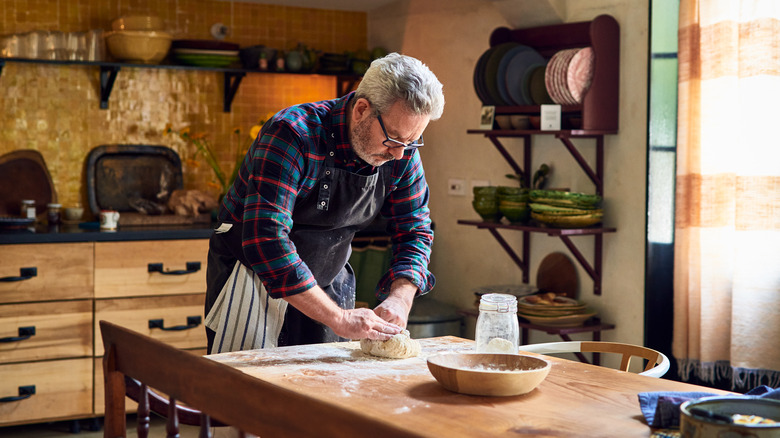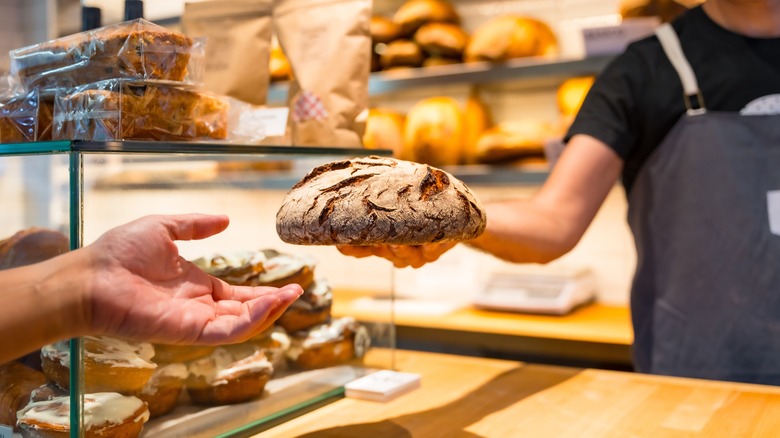What Happens When You Eat Sourdough Bread For Breakfast (And The Best Ways To Do It)
We may receive a commission on purchases made from links.
It's always exciting to shake up your breakfast routine now and again. Experimenting with different foods can boost your enjoyment, not to mention your health. As Beth Czerwony, a dietitian, explained via the Cleveland Clinic, trying new foods gives you variety, as it "not only makes your routine more exciting and fresh — it may also offer impressive nutritional benefits." That's certainly true if you're adding sourdough bread to your breakfast, since sourdough can often be easier to digest and easier to handle sugar-wise than other types of breads.
First, however, let's take a broad look at sourdough. Though sourdough bread has been around for millennia, it caught the public's eye in a big way during the pandemic. Stuck in their homes and longing for hobbies, many people discovered the beauty and simplicity of baking sourdough bread.
That was then and this is now, of course. But what's made sourdough a lasting darling with both home bakers and health advocates is the way that it gets its rise. Unlike other leavened breads, sourdough uses a natural "wild" starter, not a baker's yeast. WebMD explains that the starter contains just two ingredients: flour and water. When handled correctly and in the right proportions, the flour and water mixture produces bacteria and ferments. In a few days, the starter can become the catalyst for an airy loaf of tangy, rustic sourdough that's just begging to be on your morning menu.
A starting point for beneficial fermentation
Obviously, the starter is the key to sourdough's greatness. It's kind of amazing, too. As a 2020 article in the American Society for Microbiology notes, every starter is a little different depending on the type of flour used, the water that was available, the geographic region the starter was made, and even the gender of the baker. In fact, researchers were able to identify more than 70 yeast varieties when they examined sourdough starter samples. That means your starter could produce a sourdough loaf with signature characteristics that are unique to you and your kitchen.
Yet the starter and its bacterial agents do more than just prompt leavening and give your loaf a unique aroma and taste. As noted by Samar Kullab, a licensed and registered dietitian nutritionist, the fermentation process that leavens sourdough bread dough simultaneously generates beneficial lactic acid bacteria. And the lactic acid helps transform the finished loaf into a bread that's much friendlier to people who are gluten sensitive.
"During this process, some of the gluten is broken down, making it [the sourdough bread] easier to digest for many people," Kullab says. "Additionally, the slow fermentation helps break down starches and fibers, making them more accessible to the good bacteria in the gut, which can support better digestion and gut health."
Kinder to your gut and sugar levels
This means if you're someone who stays away from eating toast or breakfast sandwiches made with white bread leavened with baker's yeast, you may find sourdough bread a better friend for your gut. And while Samar Kullab cautions that sourdough isn't a prebiotic, she notes that it can still offer prebiotic-type benefits.
"While the probiotics from fermentation are destroyed during baking, prebiotics — non-living fibers and compounds that feed the good bacteria in your gut — remain intact," outlines Kullab, who goes by @chicago.dietitian on TikTok. "The sourdough-making process creates resistant starches and fibers that act as prebiotics, supporting the growth of beneficial gut bacteria (probiotics)." But it's not just your gut that can get a kick out of sourdough. Your sugar levels may, too, because sourdough bread ranks lower on the glycemic index than other types of bread. Consequently, it's less likely to cause your sugars to go haywire.
How low is sourdough's glycemic index? A 2022 article in Today's Nutrition gives sourdough a glycemic index rating of 54. According to the Mayo Clinic, that's low enough to call sourdough a low-glycemic food. Therefore, you're less likely to get a sugar spike when you eat it after you wake up, which can be a huge help if you're watching your sugars because of lifestyle goals or a medical condition.
Fast breakfast solutions with a sourdough touch
Like what you're hearing and want to invite sourdough to breakfast? If you already are eating bread, you could just swap it for an equal amount of sourdough. Or, you could get creative and try some sourdough recipes. For example, Samar Kullab likes to toast a slice of sourdough and then top it with layers of avocado, flaky sea salt, cottage cheese, drizzled honey, and a pinch of crushed red pepper.
Another option is a sweet and salty fig toast. It's fairly simple: Just slather soft cheese on your sourdough, then add some slices of fresh figs. However, feel free to indulge in your sourdough anyway you like. (And any time, since it's just as appealing at snacktime, lunch, and dinner.)
If you find that you enjoy the daily sourdough habit, consider buying sourdough that's made from whole wheat flour for an added nutritional burst of fiber. Alternatively, stay open to trying your hand at making sourdough in your kitchen. All you need is bread and water to begin your starter — and your prize for being patient as your starter evolves (it may take a week or longer) is waking up to a crusty loaf fresh from the bread maker or oven.



